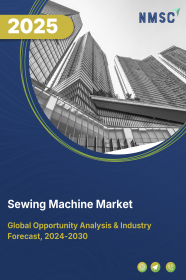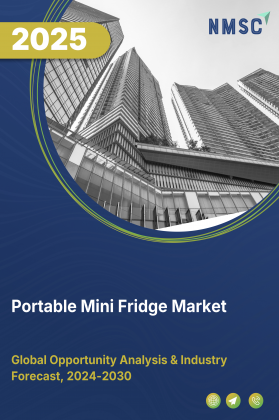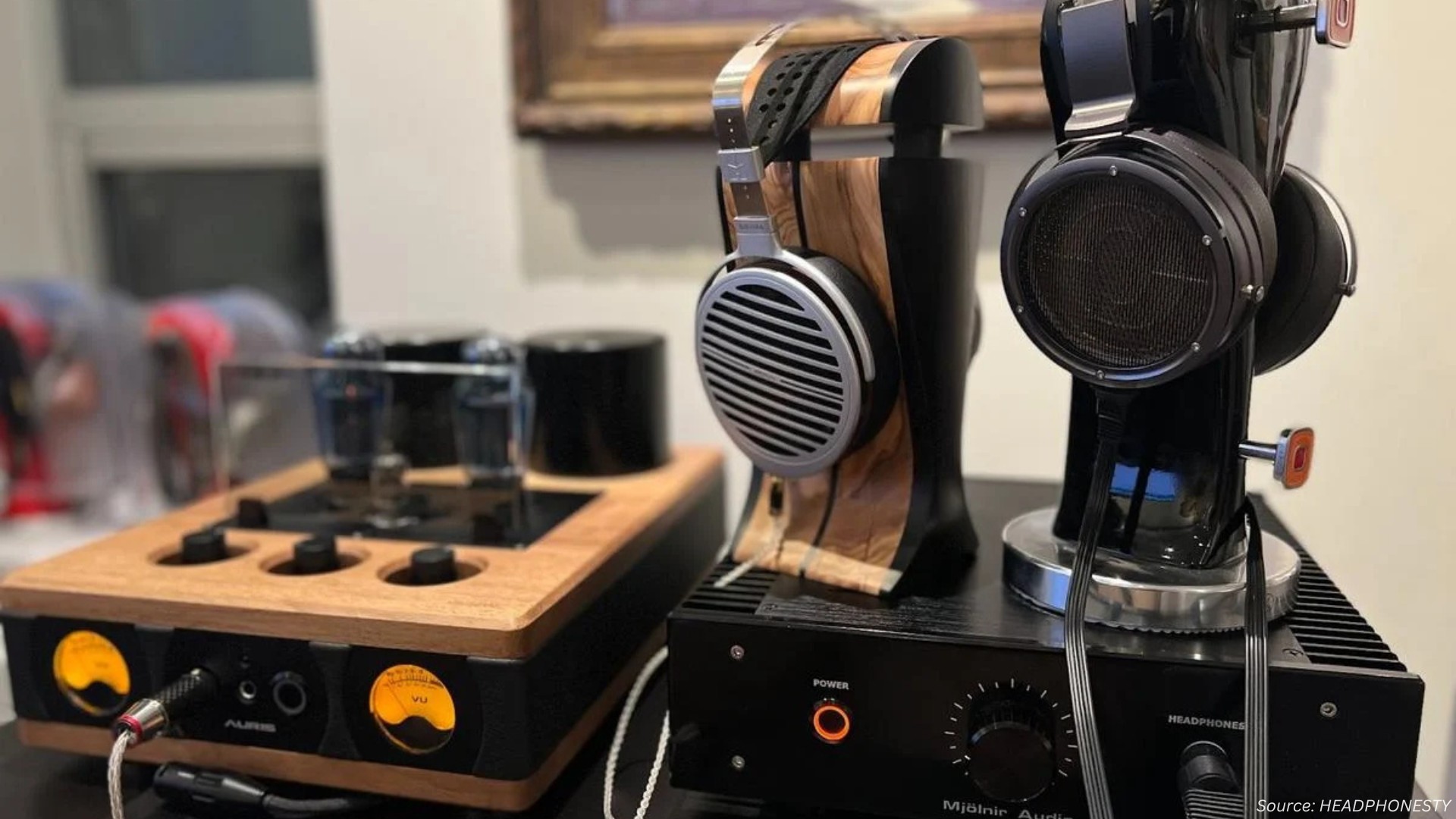
Sewing Machine Market by Product Type (Flat-Bed Sewing Machine, Cylinder-Bed Sewing Machine, Post-Bed Sewing Machine, Long-Arm Sewing Machine, and Other Product Types), by Operation (Manual Sewing Machine, Automated Sewing Machine, and Computer Controlled Sewing Machine), by Application (Apparel, and Non-Apparel), by Distributional Channel (Online, and Offline), by End User (Residential, Commercial, and Industrial) – Global Opportunity Analysis and Industry Forecast, 2024-2030
Market Definition
The Sewing Machine Market size was valued at USD 4.71 billion in 2023 and is predicted to reach USD 6.70 billion by 2030 with a CAGR of 5.2% from 2024-2030. A sewing machine is a mechanical or computerized device designed for stitching fabrics together with thread. The industry caters to household consumers seeking tools for personal sewing projects and also addresses the demands of commercial enterprises involved in large-scale textile production. The sewing machines offer a variety of advantages, including heightened efficiency, the production of professional-grade outputs, and the versatility to work with different materials, including heavier fabrics such as leather. Thus, these machines play a pivotal role in various sectors, including fashion, textiles, and crafts, providing efficient and precise stitching capabilities.
Market Dynamics and Trends
The surge in the global population has led to a significant upswing in the consumer market, particularly in the demand for clothing and other textile products. The increased need for garments and accessories has a direct and positive impact on the sewing machine industry since these machines are indispensable for the production and customization of various textiles.
Moreover, the rising trend of customization in consumer preferences increases the demand for sewing machines. Consumers are increasingly seeking personalized and unique products, extending beyond ready-made garments to include custom-designed textiles for homes and personal accessories.
This, in turn, enhances the growth of the market. In addition, the sewing machine market is driven by technological advancements such as advanced machines with cutting-edge features that include USB ports. The integration of USB ports is a significant driver, allowing users to connect external devices and expand creative possibilities.
This feature facilitates easy access to a variety of design patterns, embroidery motifs, and software updates, providing a seamless and efficient way to personalize creations. The user-friendly nature of modern sewing machines, coupled with the ability to create high-quality stitches at a faster pace, further propels the market.
Notably, Usha International launched a sewing machine, Usha Memory Craft Skyline S-9 catering to smaller commercial establishments and hobbyists. Usha Skyline-S9 is equipped with two USB ports that allow users to simultaneously insert a pen drive and connect the machine to a computer through a USB cable. The inclusion of USB ports showcases the industry's dedication to offering versatile connectivity options and expanding the creative potential of users.
However, the sewing machine market encounters restrain linked to the high initial investment for advanced and electronic sewing machines. These upfront expenses discourage some potential buyers, thereby restricting market availability and hindering overall industry growth.
On the contrary, the introduction of smart and connected sewing machines presents a significant opportunity for the sewing machine market. These innovative machines leverage advanced technologies, such as IoT connectivity, AI, and embedded smart features, to enhance the overall sewing experience. With consumer preferences leaning towards smart and interconnected devices, the integration of these technologies into sewing machines opens up new avenues for market growth in the future.
A notable example is SVP Worldwide, one of the world's largest sewing machine producers, which introduced the world's inaugural sewing and embroidery machine featuring AI and voice-control capabilities designed for home use. The development of the PFAFF creative icon 2 sewing and embroidery machine, carried out in collaboration with technology service company Etteplan, exemplifies the industry's forward-thinking approach and commitment to staying at the forefront of technological advancements. This not only enhances the current market landscape but also positions the sewing machine market for promising growth opportunities in the future.
Market Segmentations and Scope of the Study
The sewing machine market is segmented on the basis of types, application, end-user and region. Based on type, the market is segmented into mechanical, electronic, automated, embroidery, overlock, and other types. Based on application, the market is classified into apparel, shoe, bag, and other application. Based on end-user, the market is categorised into industrial, commercial, and household. Regional breakdown and analysis of each of the aforesaid segments includes regions North America, Europe, Asia-Pacific, and RoW.
Geographical Analysis
Asia Pacific emerged as the dominant force in the sewing machine market throughout the forecast period, largely propelled by the presence of a large population in the region. The significant demographic size in Asia-Pacific provides an expansive consumer base for sewing machines, catering to both domestic and industrial users. The sheer scale of the population intensifies the demand for textiles, clothing, and various stitched products, which in turn boosts the market growth. Notably, the Asia-Pacific region is home to 60% of the world's population, encompassing approximately 4.7 billion people. This demographic prominence positions Asia Pacific as a prominent leader in the sewing machine industry.
Moreover, the collaborative efforts between sewing machine manufacturers and government bodies, exemplified by initiatives including the Usha Silai School program, are instrumental in empowering women in rural areas and concurrently contributing to the expansion of the market. Usha International in partnership with government entities launched vocational training in remote regions, in India. The cooperation between industry and social initiatives will result in a more skilled workforce and potentially serves as a catalyst for the growth of the sewing machine market.
Furthermore, the surge in per capita income stands out as a crucial catalyst for the sewing machine industry, shaping consumer behavior and market dynamics in the Asia Pacific region. As APAC experiences a notable economic upswing, with its GDP rate projected to grow by 4.6 percent in 2023, up from 3.9 percent in 2022, individuals within the region are witnessing an increase in disposable income.
This economic phenomenon in APAC contributes to a rise in purchasing power and a heightened inclination towards discretionary spending. With a higher per capita income, consumers in the APAC region are better positioned to invest in tools and equipment that facilitate personal creativity, such as sewing machines. The positive correlation between rising per capita income and economic vibrancy is driving the market growth in the Asia-Pacific region.
On the other hand, the Europe sewing machine market is witnessing a significant boost due to increasing investments in research and development by the government in the fashion and textile industry. The increased focus on R&D is fostering the integration of more sustainable and responsible practices across the textile manufacturing landscape.
As the fashion industry seeks innovative solutions to reduce its environmental footprint, the demand for advanced sewing machines that align with sustainable production methods is on the rise. Notably, the UK Research and Innovation (UKRI) invested USD 8 million in the fashion and textile sector, as part of its circular fashion program, which aligns with this trend. UKRI's investment aims to foster sustainable circular business models, highlighting the pivotal role of advanced technologies in sewing machines.
Moreover, the sewing machine market in Europe is experiencing growth due to the introduction of innovative technology, including cloud-based design apps. The seamless integration of cloud-based platforms enhances the overall capabilities of sewing machines, catering to the needs of both hobbyists and professionals. Businesses are increasingly working towards integrating such innovation and introducing user-friendly features, meeting the preferences of consumers in the European market who are seeking cutting-edge features and customization options.
For instance, in October 2023 Brother introduced the innovative Artspira+ app, with augmented reality (AR) functions and seamless connectivity with compatible devices. It provides a user-friendly and efficient sewing experience. As consumers increasingly demand cutting-edge features and heightened customization options, the integration of advanced applications contributes to a user-friendly and efficient sewing experience, consequently fostering market growth.
Competitive Landscape
Various market players operating in the sewing machine market are Usha International Limited, Jack Sewing Machines, Platinum Equity Advisors, LLC., Bernina, Brother International, Janome America, Inc., PEGASUS Group, MSISM Co. Ltd., Seiko Sewing Machine Co., Ltd., Consew Ltd., Durkopp Adler, Highlead Ltd., Barudan CO., LTD., Feiya Group Co., Ltd., Yamato Sewing Machine Mfg. Co., Ltd. These market players are adopting various strategies such as product launches and collaborations to remain dominant in the market.
For instance, in September 2023, SINGER launched a sewing and embroidery machine, the SE9180, which features mySewnet integration and is designed for modern sewing enthusiasts. The machine equipped with mySewnet, offering a tailored solution for home sewists seeking to enhance their embroidery experience. This innovative machine enables users to effortlessly bring any design to life, emphasizing efficiency and quality without compromising on time.
Furthermore, in August 2023, Tacony Corporation launched a new lineup of Baby Lock sewing products, which is available at both their retailers and online stores. Following the purchase, consumers are provided with personalized retailer support and customer service. Additionally, they gain access to an array of complimentary projects, exclusive invitations to participate in specialized online communities dedicated to Baby Lock, and a comprehensive library featuring over 1,000 instructional sewing videos, among other benefits.
Moreover, in January 2023, PFAFF, launched a short seam automatic sewing machine, PFAFF 3686. The machine is an upgrade of the PFAFF 3586 short-seam automatic sewing unit and is designed to guarantee consistent quality and economic processing on a machine that is easy to operate.
Key Benefits
-
The report provides quantitative analysis and estimations of the sewing machine market from 2024 to 2030, which assists in identifying the prevailing market opportunities.
-
The study comprises a deep-dive analysis of the sewing machine market including the current and future trends to depict prevalent investment pockets in the market.
-
Information related to key drivers, restraints, and opportunities and their impact on the sewing machine market is provided in the report.
-
Competitive analysis of the players, along with their market share is provided in the report.
-
SWOT analysis and Porters Five Forces model is elaborated in the study.
-
Value chain analysis in the market study provides a clear picture of roles of stakeholders.
Key Market Segments
By Product Type
-
Flat-Bed Sewing Machine
-
Cylinder-Bed Sewing Machine
-
Post-Bed Sewing Machine
-
Long-Arm Sewing Machine
-
Other Product Types
By Operation
-
Manual Sewing Machine
-
Automated Sewing Machine
-
Computer Controlled Sewing Machine
By Application
-
Apparel
-
Non-Apparel
-
Bags
-
Car Upholstery
-
Furniture Clothing
-
By Distributional Channel
-
Online
-
Company Owned Website
-
E-commerce Site
-
-
Offline
-
Specialty Stores
-
Hypermarket & Departmental Store
-
Others
-
By End User
-
Residential
-
Commercial
-
Industrial
By Region
-
North America
-
The U.S.
-
Canada
-
Mexico
-
-
Europe
-
The UK
-
Germany
-
France
-
Italy
-
Spain
-
Denmark
-
Netherlands
-
Finland
-
Sweden
-
Norway
-
Russia
-
Rest of Europe
-
-
Asia-Pacific
-
China
-
Japan
-
India
-
South Korea
-
Australia
-
Indonesia
-
Singapore
-
Taiwan
-
Thailand
-
Rest of Asia Pacific
-
-
RoW
-
Latin America
-
Middle East
-
Africa
-
KEY PLAYERS
-
Usha International Limited
-
Jack Sewing Machines
-
Platinum Equity Advisors, LLC.
-
Bernina
-
Brother International
-
Janome America, Inc.
-
PEGASUS Group
-
MSISM Co. Ltd.
-
Seiko Sewing Machine Co., Ltd.
-
Consew Ltd.
-
Durkopp Adler
-
Highlead Ltd.
-
Barudan CO., LTD.
-
Feiya Group Co., Ltd.
-
Yamato Sewing Machine Mfg. Co., Ltd.
REPORT SCOPE AND SEGMENTATION:
|
Parameters |
Details |
|
Market Size in 2022 |
USD 4.71 Billion |
|
Revenue Forecast in 2030 |
USD 6.70 Billion |
|
Growth Rate |
CAGR of 5.2% from 2024 to 2030 |
|
Analysis Period |
2023–2030 |
|
Base Year Considered |
2023 |
|
Forecast Period |
2024–2030 |
|
Market Size Estimation |
Billion (USD) |
|
Growth Factors |
|
|
Countries Covered |
28 |
|
Companies Profiled |
15 |
|
Market Share |
Available for 10 companies |
|
Customization Scope |
Free customization (equivalent to up to 80 working hours of analysts) after purchase. Addition or alteration to country, regional, and segment scope. |
|
Pricing and Purchase Options |
Avail customized purchase options to meet your exact research needs. |




















 Speak to Our Analyst
Speak to Our Analyst

























